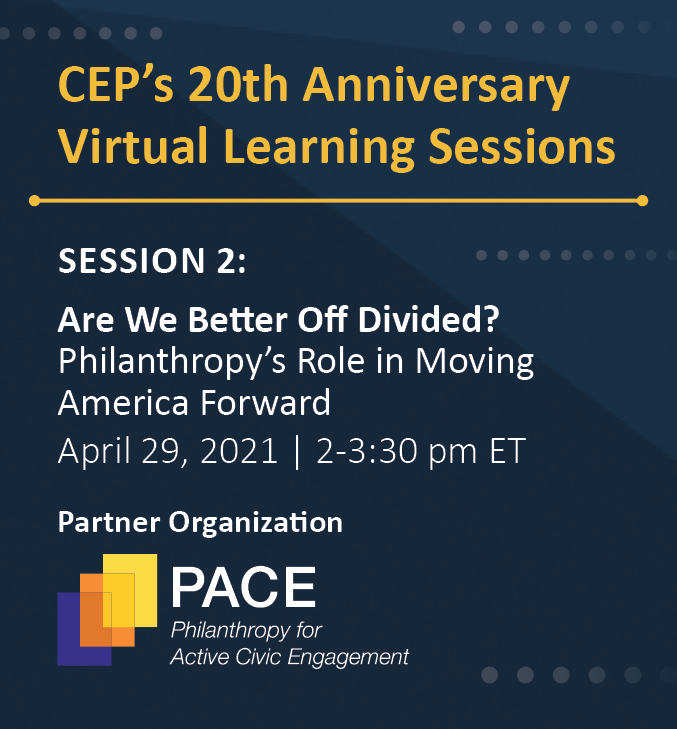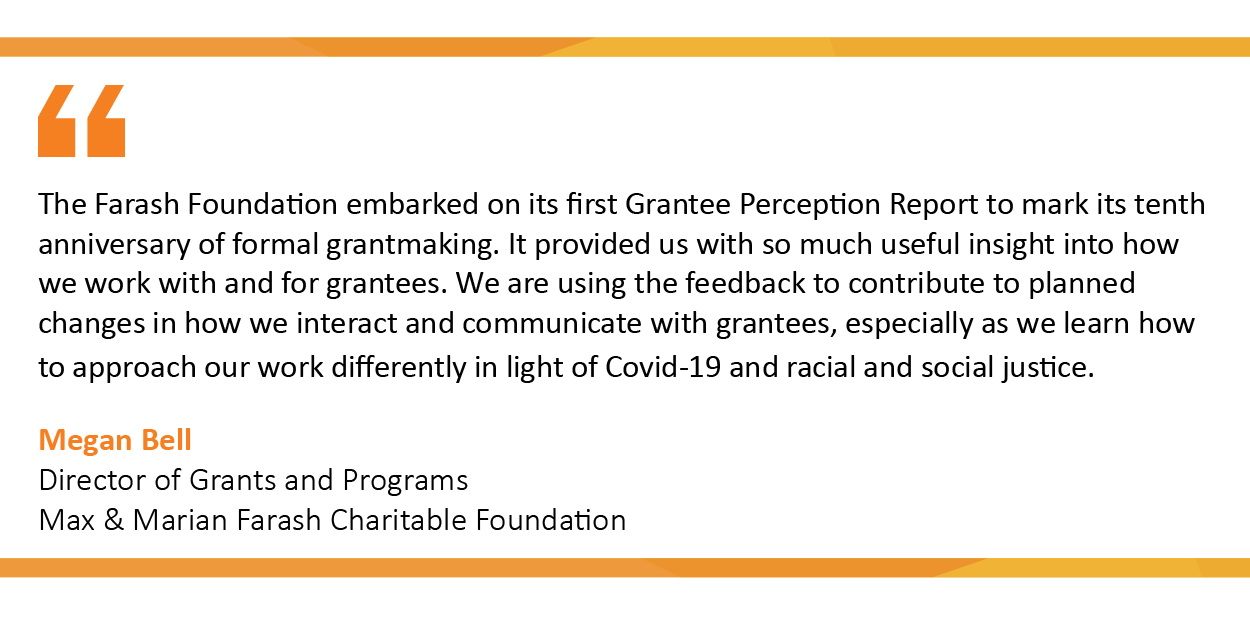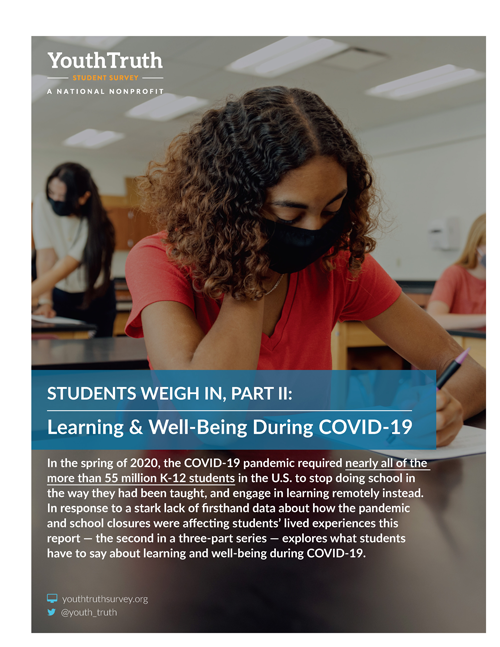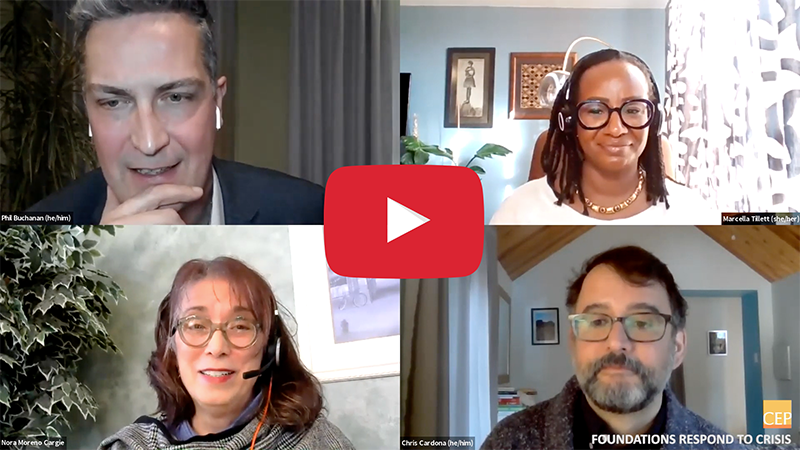Are We Better Off Divided? Philanthropy’s Role in Moving America Forward

Join CEP on April 29 for the second event in our 20th Anniversary Learning Sessions — an interactive discussion exploring philanthropy’s role in moving America forward from a time of deep polarization. This session, hosted in partnership with PACE (Philanthropy for Active Civic Engagement), will dig into effective strategies for the philanthropic sector to work across ideological differences and address rifts in American civic life.
The event will kick off with a performance and table setting from renowned R&B and blues musician and activist Daryl Davis, followed by a talk from featured speaker Eric Liu, co-founder and CEO of Citizen University (a nonprofit working to foster a culture of powerful, responsible citizenship) and author of eight books including national bestsellers The Gardens of Democracy and True Patriot. Liu will then join Nord Family Foundation Executive Director Anthony Richardson, Walton Family Foundation Executive Director Caryl Stern, and PACE Executive Director Kristen Cambell for a panel discussion moderated by Heinz Endowments President Grant Oliphant.
Today, Cambell also kicked off a new series on the CEP blog which will, leading up to the event, highlight the perspectives of a handful of leaders on bridging work — about what it can do, what it can’t, and what is needed to move forward together. This series will provide a community-informed perspective for funders to react to and build upon when considering how philanthropy can strengthen the nation’s civic and social fabric.
This will be the second event in CEP’s 20th Anniversary Virtual Learning Sessions, a dynamic series bringing donors and foundation staff together around essential topics to be considering in this time of both crisis and opportunity. We’re grateful to the Walton Family Foundation, Archstone Foundation, New Hampshire Charitable Foundation, Jacob & Valeria Langeloth Foundation, M.J. Murdock Charitable Trust, and Elmina B. Sewall Foundation for sponsoring these virtual events.
We hope you’ll join us in April! If you have any questions, contact the CEP team at events@cep.org.
Are you ready to take action on your 2021 #PlanToListen?

As the pandemic continues, the key question for funders remains: how do we change and adapt our work so we can most effectively support our grantees in a uniquely challenging time?
It’s more important than ever to make a #PlanToListen to stakeholders — carefully, regularly, and comprehensively — to rise to the challenge and be truly effective in your work this year. CEP’s assessments and advisory services, including the Grantee Perception Report (GPR), can help.
Here’s how grantee feedback gathered through the GPR helped the Max & Marian Farash Charitable Foundation navigate its crisis response:

Luminate is another funder that used the GPR to gather timely feedback from its grantee partners last year. Laura Bacon, Luminate’s director of partner support, wrote an insightful blog post laying out 10 lessons learned from the process that can help funders considering using the GPR.
If you’d like to learn more about joining this cadre of funders and centering listening in how you adapt your work in 2021, contact CEP’s Austin Long.
Students Weigh In: New YouthTruth Report Brings Students’ Experiences During COVID-19 to the Fore
In the spring of 2020, the COVID-19 pandemic required nearly 55 million K-12 students in the U.S. to stop doing school in the way they always had and to engage in learning remotely instead. During the 2020-21 school year, students continue to navigate ever-changing conditions.
YouthTruth, a national nonprofit housed within CEP that elevates student voices on critical issues in education, has long asked students about their learning experiences, social-emotional development, and well-being. In response to a stark lack of firsthand data about how the pandemic, school closures, and hybrid approaches were affecting students’ lived experiences, a new report from YouthTruth released last week explores what students have to say about learning and well-being during COVID-19.
This report — the second in YouthTruth’s Students Weigh In series — explores survey findings from more than half a million secondary students in 952 schools across 37 states during three time periods: pre-pandemic, spring 2020, and fall 2020. What did the analysis of this survey data reveal?

While students’ learning experience improved in fall 2020 relative to last spring’s emergency distance learning, not all students’ learning experiences were equal, and distance learning challenges remained. Hispanic or Latinx, multiracial, and Black or African-American students faced more obstacles to learning than did other students. Student perceptions also spoke to the mounting toll of the pandemic on their emotional and mental health. Feeling depressed, stressed, or anxious rose to the number one obstacle to learning — and a greater proportion of female and non-binary students cited challenges with mental health and well-being as compared to male students.
“Not all students are experiencing this time equally, and students are going to need different kinds of supports now and in the coming months and year,” said YouthTruth Executive Director Jen Wilka in an article in The 74 reporting on the study.
These are just a few of the insights into students’ experiences that the YouthTruth team’s data analysis revealed. For the full findings, download the report in its entirety here. And to continue the conversation, join YouthTruth on Tuesday, March 16 for a free webinar for educators and education funders digging into the data and discussing how education leaders are responding. The webinar will feature YouthTruth’s Jen de Forest and Jimmy Simpson, Jr. along with Titilola Harley, program officer for the Bill & Melinda Gates Foundation, and a panel of visionary leaders from school systems that participated in the project.
Register today and join YouthTruth in putting student voice at the center of recovery!
CEP Leaders Available to Speak to Your Audience
The need for effective philanthropy and a strong nonprofit sector could not be higher right now. Leaders at CEP are available to speak to audiences including foundation staff, trustees, donors, and intermediaries on a variety of crucial topics related to philanthropic effectiveness in this moment, such as:
- Philanthropy in the context of COVID-19 and a reckoning on racial justice
- Core principles of effective giving
- Building strong funder-nonprofit relationships
- Learning from grantee, donor, stakeholder, and foundation staff feedback
Learn more about the CEP staff that can speak on these topics (and more) on our website, and contact us to explore booking a speaker for your audience.
New Writing from CEP President Phil Buchanan
As part of the Stanford Social Innovation Review’s recent “Up for Debate” series on whether or not foundations should be increasing their payouts, this essay from CEP President Phil Buchanan argues that foundations should step up in a time of unparalleled crisis — and that strong market returns have made it easier for them to do so. “The current crises aren’t just revealing inequities: they’re exacerbating them in ways that could last generations,” Buchanan writes. “Foundations, by virtue of their long time-horizons, have the opportunity to be a counter-cyclical force.”
Additionally, on the CEP blog:
- In the wake of mob violence at the U.S. Capitol on January 6, Buchanan discusses five things those of us in philanthropy — as individuals and as a sector — must prioritize to help build a better future: 1) support grassroots efforts to strengthen democracy; 2) give up resources and power; 3) break out of our bubbles; 4) center racial equity, no matter the issue area; and 5) build on moments of hope.
- Of 218 foundations responding to a survey CEP conducted last year, 57 percent reported that fewer than a quarter of their board members were people of color. In this post, Buchanan writes about the imperative of foundation board diversity and how if foundations’ equity efforts are to be meaningful and lasting, they need to start with addressing who is sitting around the boardroom table.
- Reflecting on Funding Performance: How Great Donors Invest in Grantee Success, a new collection of essays from the Leap Ambassadors Community, Buchanan contends that listening to nonprofits and their staff is the essential first step for any funder seeking to become more effective in their work.
- As our compounded crises continue, Buchanan implores institutional funders and individual donors alike not to overlook supporting the diverse array of community-based, often small, nonprofit organizations in every state that provide vital information, connection, and opportunity to those they serve — and that have risen to the occasion for their communities amid challenging and exhausting conditions during the past year.
WATCH: Three Funders Discuss Their Crisis-Response Approach
In a webinar last month, CEP’s research team broke down the data from the latest CEP research, Foundations Respond to Crisis. The presentation was followed by a panel discussion in which Ford Foundation’s Chris Cardona, Tufts Health Plan Foundation’s Nora Moreno Cargie, and Brooklyn Community Foundation’s Marcella Tillett shared details about how each of their respective foundations have approached their crisis response. The panelists also discussed the bigger picture and what the ongoing crises mean for foundation philanthropy as a whole. Watch the recording of the conversation here.
Additionally, Tillett and her colleague Cecilia Clarke contributed a post on the CEP blog about the Brooklyn Community Foundation’s ongoing pandemic response, including how they developed and deployed an “Equity Filter Tool” to inform their grantmaking.

On the Blog
In light of spiking anti-Asian racism and horrific violence targeting Asian elders, CEP’s Grace Nicolette writes about why it’s past time for philanthropy to address its erasure of AAPI (Asian American and Pacific Islander) voices and perspectives.
Ford Foundation Executive Vice President of Programs Hilary Pennington offers four pieces of advice for philanthropy to help vanquish the elements of racism, patriarchy, and oppression that have been so central in shaping the United States — and to build a truly pluralistic, multi-racial democracy instead.
Grantmakers for Effective Organizations (GEO) President & CEO Marcus Walton discusses why centering racial equity is essential to increasing the impact of any grantmaking strategy.
Is it “heresy” to say that project grants need not be the enemy of philanthropy? Rodney Christopher, director of philanthropic services at BDO FMA, argues that, when structured differently, project grants can indeed help upend the nonprofit starvation cycle.
“The way funders show up for their communities is through their grantmaking practices,” writes PEAK Grantmaking Programs and Knowledge Director Melissa Sines in a post about the need for funders to hold the line on positive changes they’ve made in the past year. “Application processes, decision-making frameworks, grant structures and agreements…These are the true, real-world manifestations of each funder’s values.”
Adriana Craciun, Oak Foundation’s senior adviser for Organisational Development and Capacity Building, makes the case for general operating support as a key way of helping nonprofits hedge against unpredictability in a volatile world.
In this time of immense challenge, Andrea Fionda, director of programs at the Jacob & Valeria Langeloth Foundation, implores her peer funders to consider a seemingly simple yet essential question: what does it mean to be philanthropic?
Building Impact Managing Partner Danielle M. Allen shares three key steps for funders seeking to build a culture of continuous improvement at their organization.
Community Wealth Partners Senior Director, Knowledge & Content, Lori Bartczak discusses how private and family foundations should look to community foundations, given their “powerful role in directing resources to organizations meeting the greatest needs in communities,” for guidance on navigating an effective crisis response.
And Bob Reid, former CEO of JF Maddox Foundation, talks about the need for effective funder collaboration in rural grantmaking. “Resources from multiple foundations are typically needed for achieving scalable and sustainable impact in rural areas,” he writes, “meaning that effective foundation-to-foundation collaboration is essential to overcoming rural challenges.”
Support CEP’s Work with a Grant, Individual Donation, or Sponsorship
If you believe in CEP’s work, and if it benefits you and your organization as you seek to do yours, please consider making a grant or an individual contribution to CEP. Supporting CEP means supporting more effective philanthropy.
You can also support CEP through sponsorship for specific CEP events and programs, including CEP’s 20th Anniversary Virtual Learning Sessions and Season 2 of the Giving Done Right podcast. Reach out to Grace Nicolette at gracen@cep.org to learn more about these exciting sponsorship opportunities.
